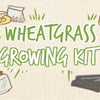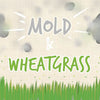How To Grow Wheatgrass: The Complete Guide
With the rise in popularity of wheatgrass, we've created a How To Grow Wheatgrass Guide. Which will help you through the process of learning how to grow, with soil, without soil, indoors and outdoors too. Included is all of the necessary information in an easy to understand format.
Not Much Time? Skip To What You'd Like To Learn...
-
What Is Wheatgrass?
-
What Does Wheatgrass Smell Like?
-
What Does Wheatgrass Taste Like?
-
How Long Does It Take To Grow Wheatgrass?
-
Why Grow Wheatgrass?
-
Health Benefits Of Eating Wheatgrass
-
Considerations When Buying Wheatgrass Seeds For Growing
-
Our Recommended Wheatgrass Product
-
How To Grow Wheatgrass
-
How To Grow Wheatgrass In Soil
-
How To Grow Wheatgrass Without Soil
-
How To Grow Wheatgrass Using Outdoor Method
-
YouTube Growing Methods
-
Buying Grown Wheatgrass
-
Popular Methods For Eating Wheatgrass
-
Is Wheatgrass A High-Risk Food?
-
Cats And Wheatgrass
-
Common Questions
What Is Wheatgrass?
Wheatgrass is defined as the first leaves that have been freshly sprouted from the common wheat plant (Triticum aestivum). Wheatgrass can be used to make wheatgrass juice, dietary supplements, or food in liquid, powder, capsule, or tablet forms.
Wheatgrass contains concentrated amounts of nutrients such as amino acids, iron, magnesium, and calcium, among other nutrients. The consumption of wheatgrass is associated with numerous health benefits, as described below. This guide also explores crucial information about wheatgrass, including its nutrition, methods for growing, and where you can buy wheatgrass.
What Does Wheatgrass Smell Like?
Wheatgrass produces a fresh ‘green’ scent that is similar to the smell of newly-mown grass. Although the smell of wheatgrass may make some people ‘instantaneously ill,’ wheatgrass lovers find this smell appealing and very tolerable.
What Does Wheatgrass Taste Like?
Wheatgrass has a mildly sweet taste that is similar to green tea. However, different wheatgrass products such as fresh wheatgrass juice, wheatgrass shots, and wheatgrass powder have different tastes. Fresh wheatgrass juice exhibits a strong taste with an earthy aftertaste, known and a raw pungent taste. A shot of wheatgrass has a bitter taste; hence it is essential to cover it with some sweet fruits to do the trick. Lastly, wheatgrass powder has a bitter earthly flavor.
How Long Does It Take To Grow Wheatgrass?
It takes between 6 to 10 days for wheatgrass to grow and reach the harvest size. However, wheatgrass seeds can germinate in as little as 2 days when grown in trays or ports. The average growing time of wheatgrass can be altered by cultural conditions such as insufficient light and water.
Why Grow Wheatgrass?
1. Sprouted Wheatgrass Contain Readily Available Nutrients
Wheatgrass is an excellent source of numerous different minerals and vitamins. It is particularly high in iron, calcium, magnesium, and amino acids, as well as vitamins A, C, and E. These nutrients play crucial roles in the human body, for example, the building and repairing of tissues. The fiber found in wheatgrass is also essential for digestive health and regular bowel movements.
2. For Fun
The process of sprouting wheatgrass can be an exciting activity and fun for most individuals because it is an outstanding activity where all members of the family may participate. The fast sprouting of roots and shoots makes both entertaining and educational experience.
3. Quicker Cooking
Soaking and sprouting of wheatgrass seeds soften them. This, as a result, makes it possible for the sprouts to cook faster compared to dried wheatgrass seeds, which take longer to cook.
4. Can Be Carried Out Indoors
Sprouting wheatgrass seeds does not require complicated and expensive equipment because all that is needed is a sprouting kit or a mason jar. Additionally, other simple requirements such as wheatgrass seeds and water for soaking and rinsing can be easily obtained to facilitate the sprouting process. Wheatgrass seeds will definitely sprout faster indoors compared to outdoors because the temperature is within the required optimum range.
5. It Is Economical
Sprouting wheatgrass at home is much more economical than buying sprouted wheatgrass from other dealers. This is because all dealers in wheatgrass sprouts are profit-oriented as compared to home-made wheatgrass sprouts that are primarily intended for domestic consumption. Notably, most equipment used in sprouting wheatgrass can be readily available at home hence saving the cost of purchasing other sprouting equipment.
Health Benefits Of Eating Wheatgrass

High In Antioxidants And Nutrients - Wheatgrass is known to be an excellent source of minerals and vitamins. These include calcium, magnesium, amino acids, and vitamins A, C, and E. Wheatgrass, just like other greens, contain chlorophyll, which contains numerous essential antioxidants, vitamins E and C, and glutathione which fight free radicals to help reduce oxidative stress and prevent cell damage. Antioxidants may also protect against various conditions like cancer, heart disease, neurodegenerative disease, and arthritis. Reference: link.
Prevention And Treatment Of Cancer - The high antioxidant content in wheatgrass suggests that the consumption of wheatgrass may be useful in killing cancer cells. Research studies have indicated that combining traditional cancer treatment with wheatgrass juice may minimize the adverse effects of cancer by killing cancer cells and reducing the development of cancer in the body. Reference: link.
Treating Gastrointestinal Distress - Traditional medicine practitioners have used wheatgrass for a long time to reduce stomach pain and manage slight gastrointestinal problems like digestive problems and diarrhea. Wheatgrass is rich in fiber, which helps in keeping the gut healthy. Researchers have also established that wheatgrass can be useful for treating ulcerative colitis, a provocative condition affecting the large intestines. Individuals who use wheatgrass for treating gastrointestinal distress usually experience reduced rectal bleeding and less disease activity. Reference: link.
Prevention And Treatment Of Type 2 Diabetes - Wheatgrass raises insulin levels and helps in lowering blood glucose. Since inflammation plays an essential role in diabetes, experts have found that wheatgrass fights inflammation hence assisting people in managing diabetes and other complications associated with the disease. Reference:link.
May Alleviate Inflammation - Wheatgrass has a high content of chlorophyll, a plant pigment that contains strong anti-inflammatory properties. Inflammation refers to a normal response that is generated by the immune system to defend the body against infection and injury. Although chronic inflammation is connected to conditions such as heart disease, cancer, and autoimmune disorders, research has shown that wheatgrass and its components are essential in reducing inflammation. Reference: link.
Considerations When Buying Wheatgrass Seeds For Growing
1. Produced For Sprouting
Buying wheatgrass seeds that have been packed for sprouting purposes usually provides a much higher rate for germination. Wheatgrass seeds produced for sprouting include seeds that have not been pasteurized; hence they naturally absorb water during the germination step and sprout.
2. Brand
It is essential to compare different brands that produce wheatgrass seeds for sprouting. While at it, it is advisable to choose brands that are both well-known and also have excellent customer reviews and feedback. This, as a result, helps to reduce the possibility of buying low-quality or damaged wheatgrass seeds.
3. Source
It is essential to ensure the wheatgrass seeds purchased for sprouting purposes are organically grown, are grown in suitable climatic conditions, and are non-GMO. This helps to ensure that the wheatgrass seeds purchased for sprouting are not of poor quality or old and also adheres to FDA standards.
Wheatgrass Nutrition (per 16 oz serving size)
-
Calories:25
-
Protein: 1 g
-
Fiber: 4 g, or 14% of Daily Value (DV)
-
Carbohydrates: 6 g, representing 2 percent of an adult’s DV
-
Calcium: 24 milligrams (mg)
-
Vitamin K: 86 micrograms, representing 70% of DV
-
Iron: 1 mg, representing 6% of DV
Our Recommended Wheatgrass Product
Terrasoul Superfoods Wheatgrass Juice Powder
 [Check The Latest Price Here]
[Check The Latest Price Here]
Price: $2.99/Ounce
Overview: Commercial wheatgrass sprouts products such as Terrasoul Superfoods Wheatgrass Juice Powder contains a rigorous version of wheatgrass. This product is 100 percent non-GMO, organic, vegan, and raw hence considered one of the essential ways of increasing protein and the intake of nutrients for everyone.
How To Grow Wheatgrass

How To Grow Wheatgrass In Soil
Equipment Required:
-
Tray
-
Glass jar/sprouting container
-
Soil
-
Mesh
Ingredients Required:
-
Water
-
1-2 teaspoons of organic wheatgrass seeds
Method For Growing:
-
Rinse the wheatgrass seeds and place them in a glass jar, then cover with a mesh.
-
Add 1 cup of water then soak for 8 hours.
-
Drain the seeds and rinse properly.
-
Fill the sprouting container with water, invert it, and drain the water through the mesh, leaving it upside down.
-
Rinse the seeds 3 times a day for 3 days.
-
When sprouts appear in 3 days, add 2.5-centimeter planting soil or organic compost to a tray (with holes at the bottom). Water then sprinkle the wheatgrass seeds across the soil.
-
Spray daily with water, the darkness will help it to grow.
-
When the grass reaches 2.5-5-centimeters, remove the lid, and continue watering daily.
-
Harvest your wheatgrass when it reaches 5 inches and cut the grass close to its root.
How To Grow Wheatgrass Without Soil
Equipment Required:
-
Mold-resistant coconut coir
-
Tray
-
Plastic wrap
-
Shaded pot
Ingredients Required:
-
Water
-
Wheatgrass seeds
Method For Growing
Part 1: Sprouting The Seeds
-
Buy organic wheatgrass seeds from a reputable retailer in bulk,
-
Rinse and drain the wheatgrass seeds before soaking them,
-
Soak the wheatgrass seeds in cool, filtered water for 9-12 hours,
-
Complete 3 soaking cycles to obtain small, white sprouts.
Part 2: Transfer The Seeds To A Growing Medium
-
Grow the wheatgrass seeds in cheap, mold-resistant coconut coir,
-
Cover 6.4 centimeters of the deep tray with 2.5 centimeters of growing medium,
-
Use kelp fertilizer and water to moisten the growing medium,
-
Spread the sprouted wheatgrass seeds over the medium in a thick, even layer,
-
Lightly sprinkle the growing medium over the seeds to cover them partially,
-
Mist the tray and cover it loosely with a plastic wrap.
Part 3: Caring for The Sprouts
-
Place the tray for 1-2 days in a warm, shaded pot,
-
Water the tray to moisten the growing medium,
-
Once the green shoots emerge, transfer the tray to a brightly lit place,
-
Harvest the wheatgrass when they are about 15-18 centimeters tall,
-
Wash and eat your harvested wheatgrass sprouts.
How To Grow Wheatgrass Using Outdoor Method
Equipment Required:
-
Rake
-
Clear plastic trays
-
Glass
-
Hoe or shovel (optional)
-
Jar lids
-
Spray bottle or hose misting attachment
-
Hose
Ingredients Required:
-
Water
-
Wheatgrass seeds
Method For Growing:
-
Fill a glass with lukewarm water and soak your wheatgrass seeds for 12 hours. Allow your soaked wheatgrass seeds to drain and dry for 12 more hours.
-
Choose a site in your yard with well-drained soil and plenty of sun for the wheatgrass seeds.
-
Remove turf, grass, rocks, and other debris from your chosen site. Use a shovel, rake, or hoe for this task.
-
Run a rake through the soil several times. Use a hose to spray the soil with water until it is moist.
-
Sprinkle your wheatgrass seeds on the soil and thoroughly water the area.
-
Use clear plastic trays to cover the wheatgrass seeds and retain the moisture.
-
Remove the plastic trays, mist the seeds twice daily for 3-4 days, then put back the clear plastic trays.
-
When your wheatgrass seedlings grow 1-1 ½ inches in height, remove the clear plastic trays.
-
Water the wheatgrass when the soil becomes dry.
-
Harvest your wheatgrass when they reach 6-7 inches tall.
YouTube Growing Methods
This tutorial provides a simple way of growing wheatgrass at home quickly in soil. The tutorial recommends sprouting 50 grams of wheatgrass seeds by first soaking the seeds in water for 8 hours, sprinkling the seeds in a sprouting tray, watering the seeds to keep them moist, and keeping the sprouting tray in partial sunlight. The sprouts will appear after 3-4 days and will be ready for harvest on the 12th day.
This 3 ½ minute tutorial shows how wheatgrass can be grown without soil within 12 days using simple equipment such as a strainer, paper towel, and plastic container. This method is mostly recommended because it discourages the development of molds. This process begins with soaking the wheatgrass seeds for 12 hours and rinsing and draining for 2-3 days. The wheatgrass sprouts will appear on day 4 and are ready for harvesting on day 12.
This tutorial shows the results of growing wheatgrass outside using simple clay trays. This method exposes the wheatgrass to more sunlight that helps to convert sugars to essential amino acids. Additionally, growing wheatgrass outdoors discourages the development of molds. It is also crucial to growing the wheatgrass in fertile soil to allow the roots to develop further into the soil and absorb water and mineral salts essential for the healthy growth of the wheatgrass.
Buying Grown Wheatgrass
Grown wheatgrass is versatile and tasty. They can be eaten in various ways such as shots, juice, and can also be eaten raw. As a result, it quickly adapts to a wide variety of cuisines.
Where To Buy Wheatgrass From
Wheatgrass sprouts are readily available in farmers’ markets, vegan stores, and also in local grocery stores. Additionally, you can order wheatgrass online from Amazon from various parts of the world.
What To Look For When Buying
Quality - It is recommended for one to buy wheatgrass while fresh to obtain a nutrient-dense meal. It is also advisable to avoid buying sprouts that have withered shoots or those that are yellowish.
Cost - It is essential to consider your budget when buying wheatgrass sprouts because they can be quite pricey. You can purchase grown wheatgrass in bulk to help you cut down the total cost, which would be quite low as compared to buying the same quantity of wheatgrass sprouts over time.
Packaging - Ensure that your sprouted wheatgrass is packaged in sanitized conditions, which helps in reducing the possibility of contamination. After buying, store your wheatgrass sprouts in clear airtight-sealed plastic containers to keep off fungus and bacteria.
Popular Methods For Eating Wheatgrass

Wheatgrass Juice
Overview:
Wheatgrass juice is an excellent source of several different minerals and vitamins that are required by the body to function well. It also helps to increase the levels of different antioxidants such as vitamin C and glutathione.
How To Make
Ingredients Required
-
1 cup of water
-
Freshly chopped wheatgrass
Instructions
-
Add water to the chopped wheatgrass and pulverize in a food processor or high-powered blender for at least 1 minute.
-
Strain the juice through a kitchen towel or cheesecloth.
-
Use the wheatgrass juice immediately or within 24 hours. You can also freeze the wheatgrass juice using an ice cube tray if it cannot be used within a day.
Wheatgrass Shots
Overview
Wheatgrass shots are known to help in protecting the body against toxins, colds, and harmful molecules. They are considered to be the center for health and contain 70 percent chlorophyll that helps to reduce the risks of cancer and fight carcinogens in the human body.
How To Make Wheatgrass Shots
Equipment Required
-
Blender
Ingredient Required
-
250 grams wheatgrass
Instructions
-
Thoroughly wash your wheatgrass using running water
-
Use fresh and green wheatgrass that is young and tender and get rid of the yellow grass. Drain completely.
-
Add your clean wheatgrass to a blender.
-
Blend the wheatgrass, add to cheesecloth, and extract the juice.
-
Consume 60-120 ml of the wheatgrass shots immediately after juicing because the juice will start to get oxidized within a few minutes, and its nutritional value starts to diminish.
Eating Raw
Overview
There are many ways of eating raw wheatgrass, such as wheatgrass powder. This can be made through dehydration or freeze-drying, and the powder can be added to smoothies and fresh juice, or blended in water.
How To Make Wheatgrass Powder
Equipment Required
-
Sweet wheatgrass seed quilt
-
HAMANA growing kit
-
Bread knife or scissors
-
Coffee grinder
-
Baking sheet
Ingredients Required
-
Wheatgrass
Instructions
-
After growing your wheatgrass for 10 days in your HAMANA Grow Kit, use a bread knife or scissors to harvest the wheatgrass.
-
Place the harvested wheatgrass on a baking sheet and bake it an oven at 200 degrees Fahrenheit for 2 hours to obtain dry and brittle wheatgrass leaves.
-
Grind your dried wheatgrass leaves in a coffee grinder to obtain wheatgrass powder for use in smoothies, salad dressing, soup, and yogurt, among others.
Is Wheatgrass A High-Risk Food?
Although wheatgrass is usually considered to be safe, in its raw form it may contain bacteria and molds that may cause infections and food poisoning..
Who Is At Risk?
1. Pregnant women
2. Children below 2 years
3. Allergic individuals (especially those allergic to grass or wheat)
Making It Safe For At-Risk Groups
Wheatgrass can be made safe for at-risk groups through boiling or steaming. Exposing wheatgrass sprouts to high temperatures is essential in disabling or killing the dangerous bacteria, which may contaminate the sprouts. Bacterial development in wheatgrass sprouts makes them unsafe for eating.
Equipment
-
Wooden steam bucket
-
Large pot
Method
-
Boil a half-way filled water pot using medium heat.
-
To steam the wheatgrass sprouts:
-
Put your wooden steam bucket in the boiling pot.
-
Add the wheatgrass sprouts and cover.
-
Steam the wheatgrass sprouts for 25-30 minutes.
-
For boiling the wheatgrass sprouts:
-
Place the wheatgrass sprouts in the boiling water pot and leave for 15-20 minutes.
Cats And Wheatgrass

Munching wheatgrass is beneficial for the health of cats. This is because the fiber present in wheatgrass helps in stimulating the digestion of cats. Wheatgrass is a natural laxative that helps in breaking down numerous constipation culprits such as fur. As a detoxifier, wheatgrass helps to flush toxins and maintain the digestive health of cats.
Why Do Cats Love Wheatgrass?
Cats love wheatgrass because it helps them to regurgitate hairballs or any indigestible substance. Additionally, wheatgrass helps cats to rid their bodies of potentially inedible or poisonous matter. Wheatgrass also contains vitamins B and E, which are essential in stimulating the nervous system, strengthening the immune system, and preventing heart disease in cats.
How Much Wheatgrass Can Cats Eat Per Day?
Health experts recommend that cats should eat a small amount of wheatgrass every day to enable them to stay healthy. Notably, using popular growing and planting kits to grow wheatgrass will allow your cat(s) to come and graze on the wheatgrass as they would like. Your cat(s) will know how much wheatgrass they want and allow the grass to grow back quickly.
Do You Have To Grow Wheatgrass Using A Different Method For Cats?
There is no need for using a different method when growing wheatgrass for cats unless the wheatgrass seeds are not healthy for the cat as the consumer. Otherwise, you can use similar techniques used for sprouting wheatgrass for humans when sprouting wheatgrass for your cats.
Common Questions
Can You Grow Wheatgrass At Home?
Wheatgrass can be grown at home in water or a container full of potting soil.
How Long Does It Take To Grow Wheatgrass?
It takes between 6 to 10 days for wheatgrass to reach harvest size. The seeds can germinate within 2 days when sprouted in trays or pots.
How Can I Grow Wheatgrass At Home Without Soil?
Wheatgrass sprouts can be easily grown without soil in 8-9 days. The requirements for this process include plates or glass jars, water, and wheat grains. First, soak the grains in fresh cold water overnight.
Thoroughly rinse and drain the water the next morning. On day 3, the wheatgrass sprouts will begin to emerge. Continue rinsing and draining the wheatgrass grains twice a day through days 4 and 5. Feathery roots may start to appear on day 5; hence thorough rinsing is required throughout all the sprouting stages.
The leafy parts of the wheatgrass will begin to appear on day 6 and day 7. Your homegrown wheat will be ready for harvesting on days 8 and 9.
Is It Better To Grow Wheatgrass With Or Without Soil?
It is better to grow wheatgrass without soil as opposed to growing with soil because it is a prettier and cheaper option.
What Is The Best Time To Drink Wheatgrass Juice?
Health experts advise that you should drink wheatgrass juice after waking up, particularly on an empty stomach. You can then have your breakfast 20 minutes after drinking the wheatgrass juice.
Does Wheatgrass Regrow After Cutting?
Yes. It is advisable to harvest your wheatgrass using a sharp, clean pair of scissors by cutting close to the soil surface. However, the regrown wheatgrass will have fewer nutrients compared to the first harvest.
How Much Wheatgrass Should You Drink A Day?
A typical liquid dose of wheatgrass should be 2 shots or between 1 to 4 ounces. The usual powdered dose of wheatgrass should be 1 teaspoon or between 3 to 5 grams. Health experts advise that you should drink an 8-ounce cup of water after drinking wheatgrass juice to help reduce the risks of side effects.
Is Wheatgrass Mold Dangerous?
Wheatgrass mold (blue fuzz) is known to be non-pathogenic hence does not cause any health problems that may harm the body.
What Type Of Wheatgrass Is Better?
Fresh wheatgrass is considered to be the best because it is highly nutritious and beneficial for the body. It is free from harmful bacteria that may cause serious health problems, especially to individuals with weak immune systems.
How Can I Make Wheatgrass Grow Faster?
It is advisable to place your wheatgrass in the warmest room or place it under a light at night to make it grow quicker.
Will Wheatgrass Grow Without Sunlight?
Wheatgrass does not require a lot of sunlight to grow. However, it needs moisture maintenance and careful heat to enable the seeds to produce healthy wheatgrass plants.
What Does Wheatgrass Taste Like?
Wheatgrass has a mildly sweet taste that is similar to green tea.

 [Check The Latest Price Here]
[Check The Latest Price Here]






Good Information. Thanks For Sharing This Blog Is Very Useful To Us.